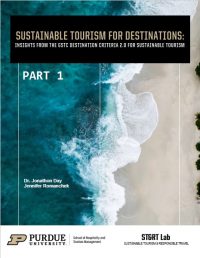Introduction

The Global Sustainable Tourism Council (GSTC), the leading organization on sustainable tourism accreditation, recently released their Destination Criteria 2.0. It provides a framework which explains destination-level sustainable tourism certification. The GSTC criteria are organized in four sections: sustainable management, socio-economic sustainability, cultural sustainability, and environmental sustainability. With these 4 sections there are 38 criteria and 174 indicators that destinations may use to assess their progress on achieving the criteria.
A New Perspective
This post examines the GSTC criteria from a different perspective. We believe we can provide further assistance to destination leaders which are trying to achieve sustainable tourism. We’ve divided the Destination Criteria into the following five categories:
- Team Efforts
- Planning
- Policy Framework
- Programs and Systems
- Performance Management
Each of these categories are closely integrated. It is fair to recognize that most activities require planning, policy support, programs incorporating a variety of activities, and performance management. Nevertheless, examining each category provides a new perspective on how to achieve sustainable tourism in destinations.
Furthermore, tourist destinations are complex systems. In this report, we use the term “destination” without designating a specific actor. It is important to note that we are not implying that either the local Destination Stewardship Organization (A1) or Destination Management Organization (DMO) is the sole responsible party.
Getting the Team Together
Finally, we believe tourist destinations that would like to be sustainable, require a team of people working towards shared goals. Some of the core principles on which sustainable tourism is developed are engagement and collaboration. While it must be expected that sustainable tourism activities will involve a large number of stakeholders, the criteria does require the development of one organization to be responsible for the general management of the endgame.
Destination Stewardship Organization [1]:
The destination should establish a designated tourism organization that has responsibility in the destination. The group will:
- Have clear, communicated, and documented responsibilities.
- Have the capability to manage of socio-economic, cultural and environmental issues
- Be adequately funded and staffed
- Be able to effectively collaborate with all other stakeholders
[1] A1: Destination Management Responsibility
The is part 2 of a series of 4 parts:
- Insights from the GSTC Destination Criteria 2.0 – Part 1
- Insights from the GSTC Destination Criteria 2.0 – Part 2
- Insights from the GSTC Destination Criteria 2.0 – Part 3
- Insights from the GSTC Destination Criteria 2.0 – Part 4
Download: pdf file available here
Source: Dr. Jonathon Day & Jennifer Romanchek, School of Hospitality and Tourism Management
Sustainable Tourism and Responsible Travel Lab ( STaRTlab)
Purdue University | College of Health and Human Science
Web adaptation: Valentina Gambino




